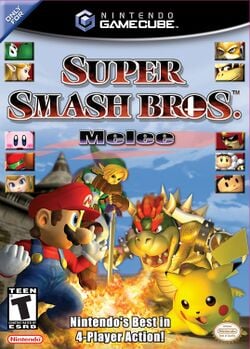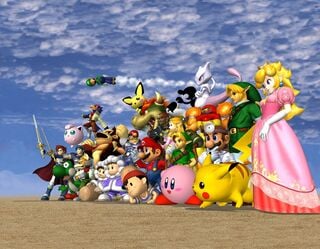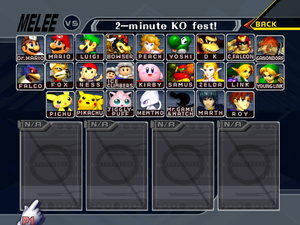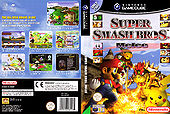Super Smash Bros. Melee: Difference between revisions
(Undid edit by 72.250.149.164: E10+ didn't exist in Melee's time, so I'm not sure this is relevant (and if it is, maybe it belongs more on the Brawl page)) |
No edit summary |
||
| Line 57: | Line 57: | ||
|[[Image:Kirby SSBM.jpg|100x100px|link=Kirby (SSBM)]]<br>{{SSBM|Kirby}}<br>{{symbol|kirby|20px}} | |[[Image:Kirby SSBM.jpg|100x100px|link=Kirby (SSBM)]]<br>{{SSBM|Kirby}}<br>{{symbol|kirby|20px}} | ||
|[[Image:Fox SSBM.jpg|100x100px|link=Fox (SSBM)]]<br>{{SSBM|Fox}}<br>{{symbol|starfox|20px|suffix=preBrawl}} | |[[Image:Fox SSBM.jpg|100x100px|link=Fox (SSBM)]]<br>{{SSBM|Fox}}<br>{{symbol|starfox|20px|suffix=preBrawl}} | ||
|[[Image:Jigglypuff SSBM.jpg|100x100px|link=Jigglypuff (SSBM)]]<br>'''{{SSBM|Jigglypuff}}'''<br>{{symbol|pokemon|20px|suffix=preBrawl}} | |[[Image:Jigglypuff SSBM.jpg|100x100px|link=Jigglypuff (SSBM)]]<br>'''{{SSBM|Jigglypuff}}'''<br>{{symbol|pokemon|20px|suffix=preBrawl}} | ||
||[[Image:Captain Falcon SSBM.jpg|100x100px|link=Captain Falcon (SSBM)]]<br>{{SSBM|Captain Falcon}}<br>{{symbol|fzero|20px}} | ||[[Image:Captain Falcon SSBM.jpg|100x100px|link=Captain Falcon (SSBM)]]<br>{{SSBM|Captain Falcon}}<br>{{symbol|fzero|20px}} | ||
Revision as of 10:36, August 22, 2014
| “ | Within Nintendo, we've had a lot of discussion about which of our most popular characters should be ready to appear in games when Nintendo GameCube comes to market. We think we've got a great answer. | ” |
| —Shigeru Miyamoto | ||
| Super Smash Bros. Melee | |
|---|---|

| |
| Developer(s) | HAL Laboratory |
| Publisher(s) | Nintendo |
| Designer(s) | Masahiro Sakurai |
| Released | |
| Genre(s) | Fighting game |
| Mode(s) | Single-player, Multiplayer (2-4) |
| Ratings | ESRB: T ELSPA: 11+ ELSPA: 3+ (re-rating) PEGI: 3+ OFLC: G8+ |
| Platform(s) | Nintendo GameCube |
| Media | GameCube Optical Disc |
| System requirements | 11 blocks of memory (an additional 2 or more blocks are needed for each snapshot saved) |
| Input methods | GameCube controller |
- "Melee" redirects here. For the game mode, see Versus Mode.
Super Smash Bros. Melee, known in Japan as Dairantou* Smash Brothers DX** (大乱闘 スマッシュ ブラザーズ DX, Dairantō Sumasshu Burazāzu Derakkusu), and often shortened to "SSBM" or "Melee", is a 2.5D fighting game for the Nintendo GameCube. It was released in late 2001 in America and Japan, shortly after GameCube's launch, and early 2002 in Europe. It is the second game in the Super Smash Bros. series, following its predecessor, Super Smash Bros. and was succeeded by Super Smash Bros. Brawl.
Like Super Smash Bros., its predecessor, Melee features gameplay unique from that of other fighting games. Compared to characters in other fighting games, Melee characters have simple movesets and lack complicated button inputs and lengthy natural combos. Instead Melee emphasizes movement and ringouts. Indeed, edge-guarding in Melee takes on much more significance than it does in most other games due to copious mid-air jumps and other methods of reaching the edge unfettered. The game has sold over seven million copies and is the best-selling GameCube game. Melee is also the first game in the series to be rated (by ESRB) T. Brawl was also rated T, making Super Smash Bros. the only game in the series to be rated E.
* Dairantou = Great Fray
**DX = Deluxe
Opening Movie
The opening movie of Melee was given particularly high attention by the developing team; according to Sakurai, the team wanted to create an entire, high-quality FMV sequence in the game in order to highlight the then newly-released GameCube console's graphical power in comparison to previous consoles. The development team worked in three different animations studios in Tokyo, Japan to finish the FMV opening.
In addition to pre-rendered cutscenes, the opening sequence also contains some shots of actual gameplay; continuing the trend started in the previous game, the opening also directly segues into the title screen.
An early opening has also been found; in this sequence, the clips of actual gameplay had been considerably changed.
<youtube>RXs4-M-ZiOg</youtube>
Characters
The cast of 25 playable characters, 26 including Zelda's alter ego Sheik, includes all twelve characters from Super Smash Bros. and thirteen newcomers. Of these, fourteen are available from the start of play (fifteen if Sheik is included), including all the "veteran" characters but Luigi and Jigglypuff.
Of the new characters, the greatest number are from The Legend of Zelda universe if Zelda/Sheik are counted as two characters to go with Ganondorf and Young Link; although the Mario series also takes three new character slots for Bowser, Princess Peach and Dr. Mario added. On top of these, two universes add two characters each, with the Fire Emblem series making its Smash Bros. debut with Marth & Roy; and the Pokémon universe adding Mewtwo & Pichu to its two existing characters. The three other characters added are Falco, a second character from the Star Fox series, and Mr. Game & Watch & the Ice Climbers from two highly venerable Nintendo series.
List of characters
| Veterans | |||||
|---|---|---|---|---|---|
 Mario |
 Luigi |
 Yoshi |
 Donkey Kong |
 Link |
 Samus |
 Kirby |
 Fox |
 Jigglypuff |
 Captain Falcon |
 Ness | |
| Newcomers | |||||
 Dr. Mario |
 Peach |
 Bowser |
  Zelda/Sheik |
 Young Link | |
 Ganondorf |
 Falco |
 Pichu |
 Mewtwo |
||
 Ice Climbers |
 Marth |
 Roy |
 Mr. Game & Watch | ||
Non-Playable Characters (all playable using Action Replay)
| Bosses | |||||
|---|---|---|---|---|---|
 Master Hand (excluding glitch) |
 Crazy Hand |
 Giga Bowser | |||
| Non-bosses | |||||
 Sandbag |
 Fighting Wire Frames | ||||
Bold denotes unlockable characters. Italics denote characters that did not return in Super Smash Bros. Brawl.
Stages
There are eighteen starter stages and eleven more which can be unlocked.
Single-Player stages
These stages cannot be unlocked, and can only be played under certain circumstances.
- Target Test Stages
- Snag the Trophies
- Race to the Finish
- Mushroom Kingdom
- Underground Maze
- Brinstar Escape Shaft
- F-Zero Grand Prix
- Rest Station
- Home-Run Stadium
- Majora's Mask
- Goomba
- Entei
Debug-Only Stages
These stages can only be used when the game is hacked. Some are functional; most are not.
Functional
- TEST
- Zelda/Sheik's Target Test Stage
Non-Functional
* Can be activated with other hacks, but not Debug Mode.
Modes
1-Player
- Classic Mode
- Adventure Mode
- All-Star Mode (must be unlocked)
- Event Match
- Stadium
- Training
Multi-player
Action Replay
Unlockables
The game features several points to be unlocked, most of which include the trophies, unlockable characters and stages. Some of them are unlocked by a special way, like achieving a certain distance on the Home-Run Contest, while others are obtained by the Lottery. For a full list, see List of unlockables (SSBM).
Reception
| Melee reviews | |
|---|---|
| Publication | Score |
| Edge Magazine | 6/10 |
| Eurogamer | 10/10[1] |
| Famitsu | 37/40 |
| GameSpot | 8.9/10[2] |
| IGN | 9.6/10[3] |
| Nintendo Power | 5/5 [4][5] |
| Official Nintendo Magazine | 95% |
| Compilations of multiple reviews | |
| Metacritic | 92/100[4] |
| Game Rankings | 90.30%[5] |
Melee was well-received in many quarters and is the GameCube's top-selling game. More than seven million copies of Melee were sold as of March 10, 2008. It was the fastest-selling GameCube game in Japan and sold 358,525 copies within four days of its release. In North America, it sold 250,000 copies within nine days of its release. It was the first GameCube game to sell over a million copies, an achievement reached only two months after its release.
Melee has received critical acclaim from reviewers, and has received high rankings on many gaming sites, such as GameRankings, IGN, and GameSpot. GameSpy commented in their review that "you'll have a pretty hard time finding a more enjoyable multiplayer experience on any other console".[6] Reviewers compared the game favorably to the original Super Smash Bros., commonly due to the large amount of new content added to the sequel, with IGN's Fran Mirabella III saying it was "in an entirely different league than the N64 version".[3] The improved graphics were also welcomed, and GameSpot said that "the character models are pleasantly full-bodied, and the quality of their textures is amazing".[2] Planet GameCube's Mike Sklens also rated it as "one of the best sounding games ever",[7] while GameSpot's Greg Kasavin commented that "it all sounds brilliant".[2]
Common criticisms of gameplay included the controls' over-sensitivity[6] and "hyper-responsiveness", with characters easily dashing and precise movements difficult to perform,[2], as well as the fast-paced gameplay, with Nintendo Spin's Clark Nielson stating that "Melee was too fast for its own good".[8] Many gamers additionally criticized the game for being too similar to the original, and GameCritics.com's Caleb Hale called it "every bit as good as its Nintendo 64 predecessor. The game doesn't expand much past that point".[9] Super Smash Bros. Melee has received many gaming awards. GameSpy chose it as Best Fighting GameCube Game in their "Best of 2001" awards[10], IGN's reader choice chose it as Game of the Year,[11], Electronic Gaming Monthly chose it as Best Multiplayer and Best GameCube Game,[12], and GameSpot chose Melee as the Best GameCube Game and tenth best game of the year.[13][14].
Changes from the original
While Melee mainly follows the same formula introduced in the original game by retaining most elements, several differences exist between the two games. The following list, while not all-inclusive, notes several of the changes. Note that this list does not include obvious changes, such as a different button scheme/controller and Melee-only characters and items.
- The general pacing of the game has been increased; freeze frames have been reduced, KOs off the top blast line finish sooner, and characters move faster in general, as gravity and falling speed values have been made higher, and more forward momentum is now conserved from a dash when jumping.
- Hitboxes now use spheres and tubes instead of cubes.
- Damage is now dealt and tracked with decimal numbers instead of integers, making moves of any damage equally vulnerable to staleness.
- Angle indicators have been removed.
- Stale-move negation has been redesigned; moves now feature a gradual drop in power if used repeatedly instead of a single large drop in power when used once, and using a move less frequently but still often gives less of a penalty then using the move the same number of times consecutively. For consecutive hitting attacks, once the first hit connects, all others become one level more stale.
- Weight differences have been made less drastic; characters heavier than Mario are lighter, while characters lighter than Mario are heavier, so overall weight is slightly less of a factor in knockback.
- The amount of hitstun a character suffers has been decreased, being reduced from x0.533 the amount of knockback to x0.4.
- Midair characters can now drop through soft platforms by holding down on the Control Stick, improving aerial movement.
- Directional influence revamped: in addition to shifting into a direction while in hitlag (SDI), characters can also alter the angle they are launched into by holding into a direction, as well as get a weaker additional shift into the direction the Control Stick is held (ASDI).
- Most aerial attacks have been decreased in damage. All of them now have unique landing animations, and L-canceling now just halves the landing lag of an aerial rather than making the character assume their regular landing animation. Characters can now, however, fast fall at any time during aerials, so they can be L-canceled earlier, introducing the highly-competitive SHFFL and allowing character to perform more extensive combos within Melee's new physics.
- Smash attacks can now be charged for extra damage and knockback. Most smash attacks have received a power decrease to balance this out.
- Meteor smashes can now be canceled (with a loud swishing sound and the character glowing briefly white while doing so), though certain moves "fall through the cracks" and cannot be. Moves that can meteor smash are also generally much slower in all aspects.
- Angling forward tilts and smashes now either increases or reduces their damage, depending on the angle, but most of them now have less angles.
- Characters now have a side special move, bringing the total number of special moves per character to 4. Some veterans gain a new move for their side special, while others (like Link and Jigglypuff) gain a new neutral special, with their old one becoming the side special.
- Shields now last for a shorter time, and characters now take longer to drop them, though they receive less shieldstun from attacks. The game now uses two different sounds for when a shield is broken by either an opponent or the character itself, the former being higher-pitched.
- Characters can now sidestep dodge and air dodge, which results in the removal of shield platform dropping and the addition of wavedashing.
- Characters can now powershield and lightshield (the latter function makes a character`s shield bigger than usual, but they slide farther from shielding attacks).
- Characters can now tech on walls, ceilings and ledges.
- Characters hanging on ledges can now get up by jumping from them, and they can also be sweetspotted during the ending lag of recovery moves. Characters can prevent grabbing them by holding the Control Stick down.
- Characters now have a unique animation for running grabs, which is generally slower and farther reaching than their standing/walking grab.
- Jump-canceled grabs are implemented: dashing characters can now use their regular grabs by preparing a jump and then grabbing before leaving the ground, making them faster and with longer reach, depending on the characters' dash speed and traction.
- Grabs can now be escaped should the grabber wait too long before throwing, with the time until escaping dependent on the grabbed character's damage (the more damage they have, the longer they can be held). Grabs now have increased ending lag, so they cannot be used in repeated sucession as effectively.
- Characters now have an up throw and a down throw in addition to a pummel. Some veterans have had throws reassigned (for example, Kirby and Jigglypuff's old forward throws are now their up throws, Captain Falcon's old forward throw is now his down throw, and they have gained new forward throws).
- Throws are additionally weaker in general, with less damage and knockback, and most throws are now meant to start combos instead of being KO moves. This, combined with the introduction of up and down throws, introduces many more options for chain throws. The majority of throws now also have variable speed depending on the opponent's weight (lighter characters are thrown faster), and many others also consist of two hits, with the first hit being able to damage nearby opponents.
- Certain characters can now use their extended grab in midair to wall grapple.
- Certain characters can now wall jump.
- Moonwalking is possible (with Captain Falcon being the most prolific user of it).
- If an already struck character is hit by another attack 10 frames afterwards while still in hitstun, the knockback power and angle of both attacks is scaled for the second hit, rather than being completely replaced.
- Tumbling can be stopped by quickly tapping the Control Stick sideways.
- Characters can now only be KO'd by the top blast line if they are in hitstun when sent upwards. Screen KOs have been added as well, and foes on extensive team battles (such as in Multi-Man Melee) now cannot be Star KO'd nor Screen KO'd, making them significantly faster.
- Items can now be grabbed before coming to rest, and can also now be grabbed by aerial characters.
- All characters can walk while holding a heavy item, though very slowly; Donkey Kong remains the only one who can jump. They can also be thrown upwards and downwards, like regular items.
- Healing items can now be consumed while wielding another one.
- Unique on-screen appearances have been removed; all characters share the same animation of a trophy coming to life.
- A stock match can now have a maximum time limit set. Many other additional rules have also been added, such as taking out stages from random selection, controlling the way in which stages are chosen, or altering the battles' damage ratio.
- Bonuses can now be earned in both single player modes and multiplayer matches, and a lot more bonuses have also been added, changing from being 57 to 249.
- Records are not saved if a match is forfeited.
- The camera controls on the pause screen have been extended to allow freedom of focusing on other characters. A Camera Mode has been introduced where players can additionally slide it across the stage and take snapshots, which are saved into the Memory Card occupying additional slots.
- Players can now use personalized names for battles, which also get records saved.
- 1P Game is known as Classic Mode, with the opponents before the final stage now being random rather than always the same, and various other single player modes such as Adventure Mode and All-Star Mode have been added.
- Training mode now has many more options, such as battling with more than one CPU, adjusting their damage percentage, or even controlling them by a human player if additional controllers are plugged in. The longest combo achieved with each character is also saved afterwards.
- Special Melees have been introduced, which include battling with giant or invisible characters, using stamina as opposed to damage, and even battling at a faster or slower speed. A Tournament mode has also been added.
- The Board the Platforms bonus game has been removed, with the Snag the Trophies bonus game being introduced, and Race to the Finish being revamped.
- Coins are now used for continuing on 1P modes and earning trophies: these are obtained by winning battles on either regular 1P or Versus modes, the amount depending on how long they take.
- Trophies have been added, which can be collected in the Lottery, 1P modes or by specific means, then viewed in detailed ways. All characters also have three trophies of themselves, replacing the previous game's biographies.
- More complex records are saved by the game, such as the total of times it has been turned on, current characters with the most KOs, falls and SDs, or even the total distance walked by all characters.
Tournament play
Melee is widely known for its large and intricate tournament scene. The generally accepted birth of the tournament scene was caused by the creation of the Tournament Go series. Recently, the tournament scene has been bolstered by grand-scale tournaments such as the MLG series.
The community has constructed a set of standard tournament rules to regulate tournament play. All matches are played with timed stock (usually four lives and eight minutes), with items turned off and restrictions on legal stages. These regulations are enacted to ensure that gameplay at the highest level remains fair and interesting.
Gallery
Trivia
- Super Smash Bros. Melee marks the first playable appearance on the Nintendo GameCube for 25 out of the 26 playable characters. The only character who had been playable on the GameCube beforehand was Luigi in Luigi's Mansion.
- Despite there being 5 "?"-marked character boxes initially, there are a total of 11 unlockable characters, with the ones not marked by a "?" being clones. Given that Melee directly identifies these characters as clones by how they're presented on the selection screen, this raises interesting questions about how they were treated by the development team.
- Oddly enough, when Luigi becomes unlocked, he takes his place beside Mario and bumps Pikachu down into a "?" box. Pikachu being sandwiched in the Mario section in the first place appears to have been done so the bottom-row placement of the "?" boxes is aesthetically pleasing without having to move anything else around.
- Melee is the only game in the series where Ness and Captain Falcon are starter characters. They were unlockable characters for the rest of the games in the series.
- This is the first game that has villains-including Bowser (the main antagonist of the Super Mario franchise) and Ganondorf (the main antagonist of the Zelda franchise).
- Melee is the first game in which The Legend of Zelda and Star Fox universes (which previously had one character) have multiple characters.
References
- ^ http://www.eurogamer.net/articles/r_ssbm_gc
- ^ a b c d http://uk.gamespot.com/gamecube/action/supersmashbrosmelee/ Cite error: Invalid
<ref>tag; name "Gamespot" defined multiple times with different content - ^ a b http://uk.cube.ign.com/articles/166/166387p1.html Cite error: Invalid
<ref>tag; name "IGN" defined multiple times with different content - ^ a b http://www.metacritic.com/game/gamecube/super-smash-bros-melee
- ^ a b http://www.gamerankings.com/gamecube/516492-super-smash-bros-melee/index.html
- ^ a b Williams, Bryn (2001-12-03). Super GameSpy: Smash Bros Melee review. GameSpy. Retrieved on 2013-06-05.
- ^ Sklens, Mike (2001-12-18). Nintendo World Report: Smash Bros Melee review. Nintendo World Report. Retrieved on 2013-06-05.
- ^ Nielsen, Clark (2007-05-27). The Games We Hate. Nintendo Spin. Retrieved on 2013-06-05.
- ^ Hale, Caleb (2002-02-20). GameCritics.com: Smash Bros :Melee review. GameCritics.com. Archived from the original on 2007-12-31. Retrieved on 2013-06-05.
- ^ GameCube Fighting Game of the Year: Super Smash Bros. Melee. GameSpy. Archived from the original on December 20, 2007. Retrieved on 2013-06-05.
- ^ Insider: Reader's Choice awards. IGN (2001-01-19). Archived from the original on 2004-08-13. Retrieved on 2013-06-05.
- ^ 2001 "Gamers' Choice Awards". Ziff Davis, Electronic Gaming Monthly (April 2002). Archived from the original on 2008-03-06.
- ^ The Best and Worst of 2001: Best GameCube Game. GameSpot. Retrieved on 2007-12-23.
- ^ The Best and Worst of 2001: The Top Ten Video Games of the Year. GameSpot. Retrieved on 2013-06-05.
































